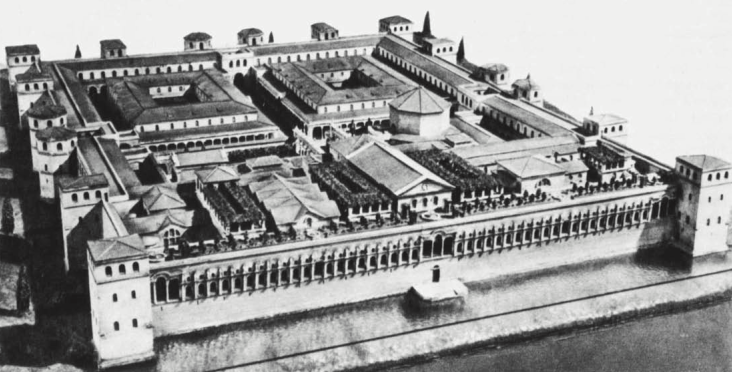Palace of Diocletian. Spalato (Split), Yugoslavia, about 305
The soldier-emperor Diocletian built a retirement palace on the Adriatic coast near his birthplace, Salona, where he spent the last decade of his life upon his voluntary abdication in 305.
Like a third-century fortified villa, the palace was shut off from the world by thick walls forming a squarish trapezoid. To the north, east, and west the walls were fortified by projecting square and octagonal towers and were pierced in their middles by gates. Overlooking the sea, the south wall was a monotonous arcaded gallery broken only by three loggias and flanked by corner towers.

Inside, two colonnaded thoroughfares intersected, dividing the palace into quadrants. The principal buildings were situated seaward and included a peristyle. To the east lay the emperor's domical mausoleum and to the west two rotundas of indeterminate function and a small classical temple, perhaps dedicated to Jupiter. South of these structures were the state reception rooms and private apartments. Since the site here slopes sharply toward the bay, these required vaulted substructures. The major buildings were sometimes decorated economically, sometimes sumptuously, with imported marbles, mosaics, and carved architectural elements. The less well preserved buildings in the northern quadrants of the palace presumably housed the emperor's bodyguard and servants.
The palace design was influenced by those of villas and army camps (castra). The seafront facade, with a portico between corner towers, derives from plans of villas known to us principally in the Western provinces. Roman military camps were divided into quadrants by two major arteries, with the headquarters and residence of the commanding officer near the intersection of the streets. Spalato follows the plan of late Roman castra, in which the living and working chambers were situated against the sides of the camp, leaving open the area in the middle for the administrative center. The assimilation of the castrum in the design of an imperial palace coincides with the militarization of the Roman state's administration as reconstructed by Diocletian and heralds developments in Byzantine palaces, Arab villas, and medieval castles.
Today, scholars tend to agree that an architect and workmen from the East worked on the palace, for some of its most conspicous features derive from Asia Minor or Syria: the preference for fine, squared-stone masonry, the use of brick vaulting, including pitched brickwork (cf. no. 107), the arched entablature or arcuated lintel and the arcading of the columnar screens in the peristyle, the engaged columns on isolated corbels, and the decorative open relieving arches over flat-arch lintels. Other features seem Italian: the plan of the octagonal mausoleum with alternating rectangular and semicircular niches piercing its interior circular wall, the round, domed vestibule behind the peristyle, the framing of the arches of the seafront gallery between the half columns of an applied decorative order, and the apsed audience hall in the southwest sector of the palace. This amalgam, which underscores the ubiquity of ideas and motifs in the imperial architecture of the Tetrarchy, survived into Constantinian times. Bibliography: Niemann, 1910; Hebrard and Zeiller, 1912; Duval, 1965; J. and T. Marasovic, 1970; Marasovic et al., 1972.
Date added: 2025-08-01; views: 176;
